Home / Organocuprates (Gilman Reagents): How They’re Made
Organometallics
Organocuprates (Gilman Reagents): How They’re Made
Last updated: April 17th, 2023 |
How Gilman Reagents (Organocuprates) Are Made
- Gilman reagents (organocuprates, often written as “R2CuLi” are not made the same way as Grignard or organolithium reagents.
- Instead of being made from alkyl halides, they are made through the reaction of an alkyllithium with a copper salt (e.g. CuBr)
- The use of two equivalents of alkyllithium (R-Li) relative to copper (CuX) is important for forming the organocuprate
- If only one equivalent is used, the result is an “organocopper” reagent (R-Cu) which is a poor nucleophile.
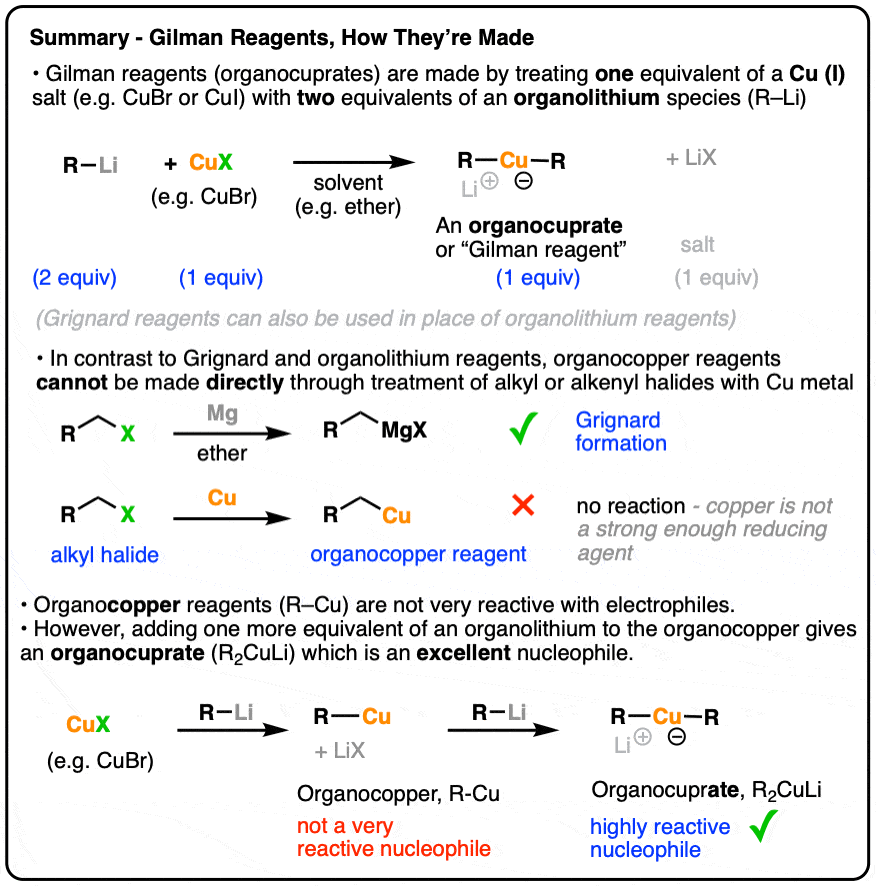
Table of Contents
- Organometallics: What About The Rest Of The Periodic Table?
- Can We Make Other Organometallics The Same Way We Make Grignards (And Organolithiums)?
- Formation of Organometallics From Alkyl Halides Involves Reduction
- Direct Formation of Organometallics From Cu Is Much More Difficult Than From Mg or Li
- A Work-Around: Transmetallation
- OrganoCOPPER reagents: Way Less Reactive Than Grignards
- OrganoCUPRATES: The Much-More-Reactive Cousins of OrganoCOPPER Reagents
- Summary: Organocuprates
- Notes
- (Advanced) References and Further Reading
1. Organometallics: What About The Rest Of The Periodic Table?
In this whole series on organometallics so far has covered exactly TWO metals: lithium and magnesium (with a very brief head-nod to sodium and the comparatively useless Wurzt Wurtz reaction.)
There are dozens of other metals on the periodic table. What about organometallic compounds of them ?
Great question! (That’s also the first thing you say when someone asks you a question you want to dodge.)
Much as we’d love to, we just don’t have enough time to get into the full glory of organometallic chemistry in an introductory course. (If you’re curious, may I suggest The Organometallic Reader?)
In this post and the next we’ll give perfunctory treatment of some organometallic compounds of copper, and perhaps in a later post have something cranky to say about palladium, and call it a series.
Let’s get started.
2. Can We Make Other Organometallics The Same Way We Make Grignards And Organolithiums?
First, recall what we’ve said so far about how to make organometallic compounds: basically, take an organohalide, add magnesium or lithium, and stir. (See post: Synthesis of organolithium and Grignard reagents)
You might wonder: is it this easy for making other organometallics?
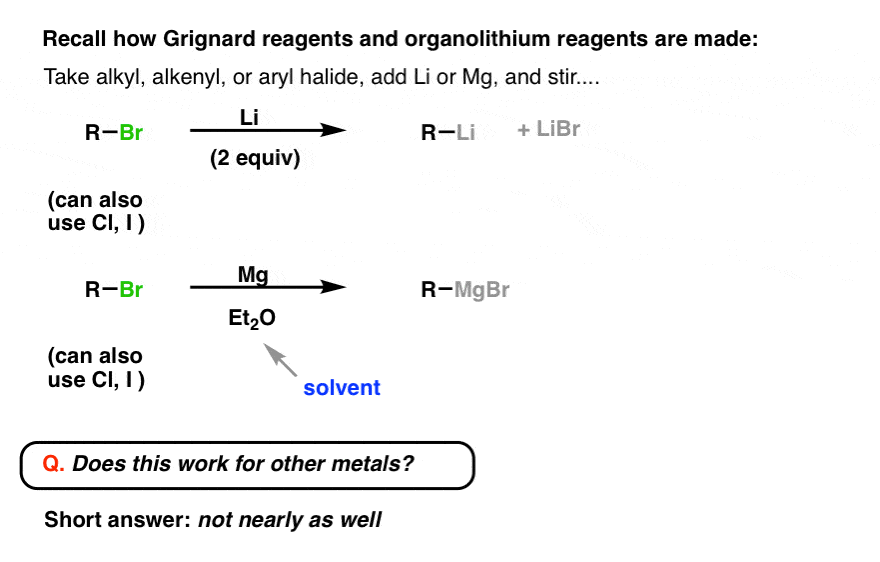
The short answer is: for most metals, it doesn’t work nearly as well.
3. Formation of Organometallics From Alkyl Halides Involves Reduction
Remember that formation of organometallic compounds from organohalides is a reduction reaction. Here it’s illustrated for the synthesis of organolithium compounds.

Notice how the polarity on the carbon changed from positive to negative? Not that we normally do such things, but if you keep track of the carbon oxidation state, you’d see that it changed from (–2) to (–4). (See post: Calculating the oxidation state of carbon)
This works well for lithium and magnesium because those metals are so easily oxidized. We can quantify this by looking at a table of oxidation potentials.
See how lithium, sodium, and magnesium are near the top of this table of oxidation potentials for metals? They’re easily oxidized – which means they are extremely strong reductants.
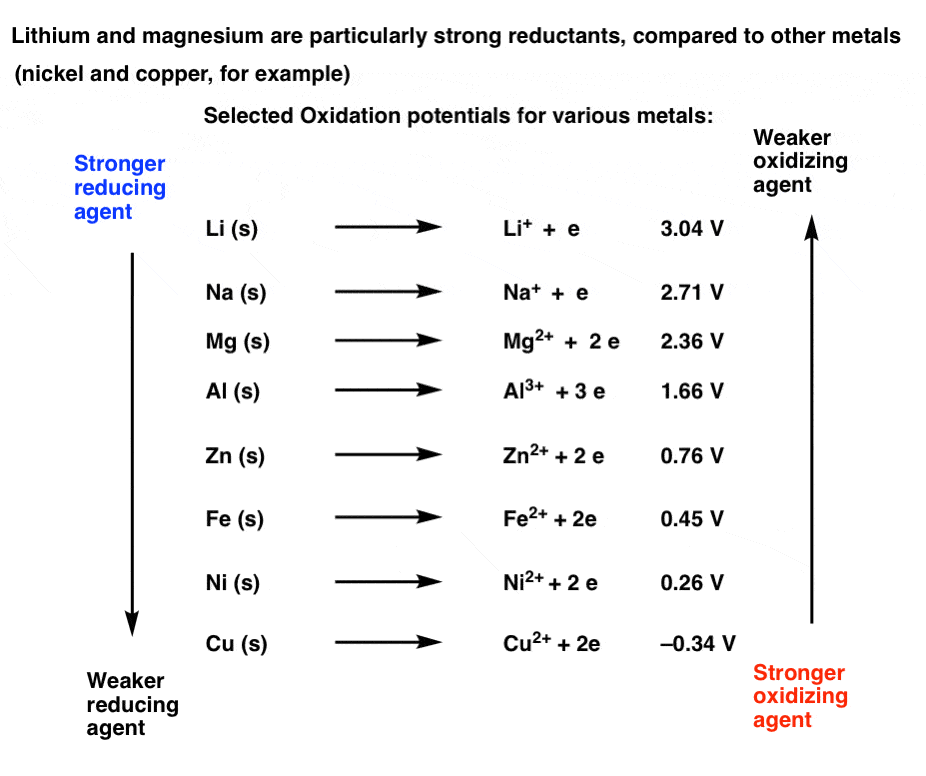
[note that these voltages are in aqueous solution, so take these numbers with a grain of salt for reactions performed in organic solvents].
As we move from lithium down the table to metals like nickel and copper, we should expect the reduction reaction should become progressively more difficult. And it is!
4. Direct Formation Of Organometallics From Metals Like Cu Is Much More Difficult Than For Mg or Li
In other words, direct formation of an organometallic from the organohalide and that metal [a process we call ‘insertion’ , or “oxidative addition”, FYI] is less favoured.
Look at copper for instance: the “direct reduction” doesn’t work nearly as well as it does for Li and Mg.
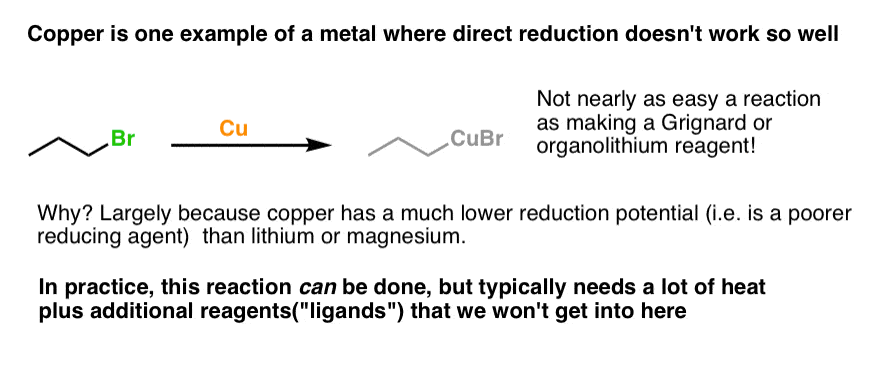
I don’t mean to imply that it can’t be done, but it generally requires heat and the addition of extra reagents that influence the oxidation potential of the metal (these are called ligands) in order to get this reaction to go.
5. A Work-Around: Transmetallation
Let’s say we really need to make an organometallic compound of copper. Can we get around this difficulty we generally experience in direct reduction? Yes – there’s a workaround.
What we can do instead is to start with a pre-made organometallic (such as an organolithium or Grignard reagent) where the reduction has already occurred. We can then add a copper (I) salt such as CuBr or CuCl.
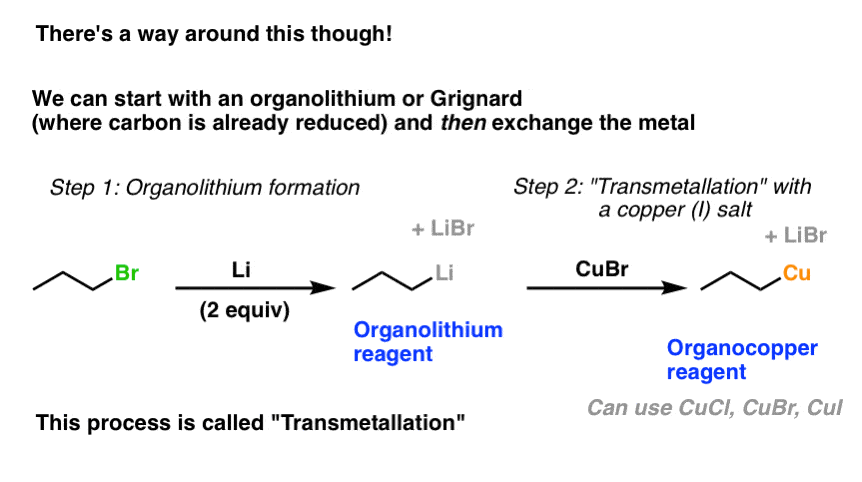
The result is displacement of the halide at copper by the carbon bound to lithium, and we form an organocopper reagent (plus a lithium salt). [You might wonder: why does this work at all? Note 1. ]
Yahoo for shortcuts!!
(Although not shown, this also works for Grignard reagents)
Now that we have a way to make organocopper reagents, the next question is: so what? What can we do with them?
6. Organocopper Reagents: WAY Less Reactive Than Grignards
In comparison to Grignard and organolithium reagents which are violently destroyed by water (and sometimes air) organocopper reagents are fairly sedate. For instance, there are organocopper reagents that you can leave out in the air without incident, like 1-hexynylcopper.

Also, organocopper reagents don’t add to carbonyls or epoxides like organolithium reagents or Grignard reagents do.
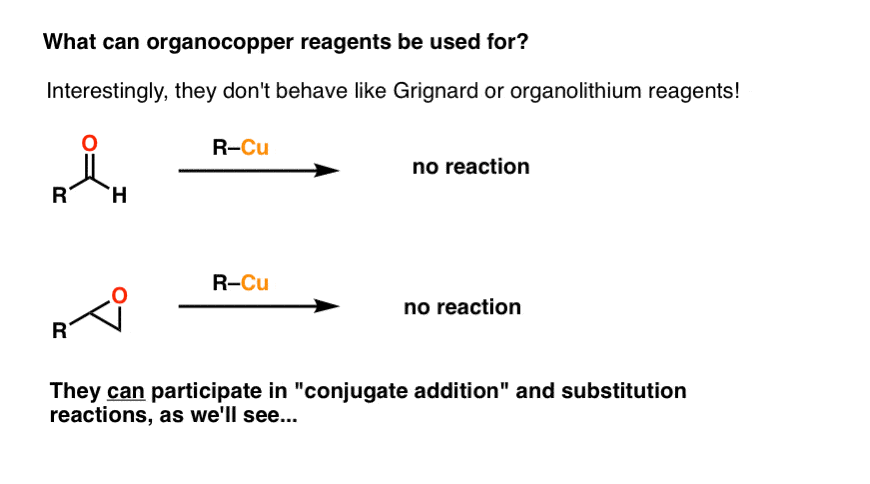
While organocopper reagents are interesting, it turns out that they have a chemical “cousin” that is even more versatile, reactive, and useful, and for that reason we will from this point further focus on these species: “organocuprate” reagents.
7. Organocuprates: Far More Reactive “Cousins” Of Organocopper Reagents
In the 1940’s Iowa chemist Henry Gilman discovered that adding one further equivalent of an organolithium reagent to an organocopper compound resulted in an “organocuprate” reagent, with two Cu–C bonds and is also comprised of a positive counter-ion (lithium in this case).
[Note that “-ate” at the end. Notice how many species that end in the name “ate” [e.g. sulfate, nitrate, tosylate] are negatively charged?]
Organocuprates, with the general formula R2CuLi , have the same general pattern of reactivity as organocopper reagents, but are much more reactive. These compounds are commonly referred to as “Gilman reagents” in ol’ H.G.’s honour. [Why are they more reactive? Note 2].
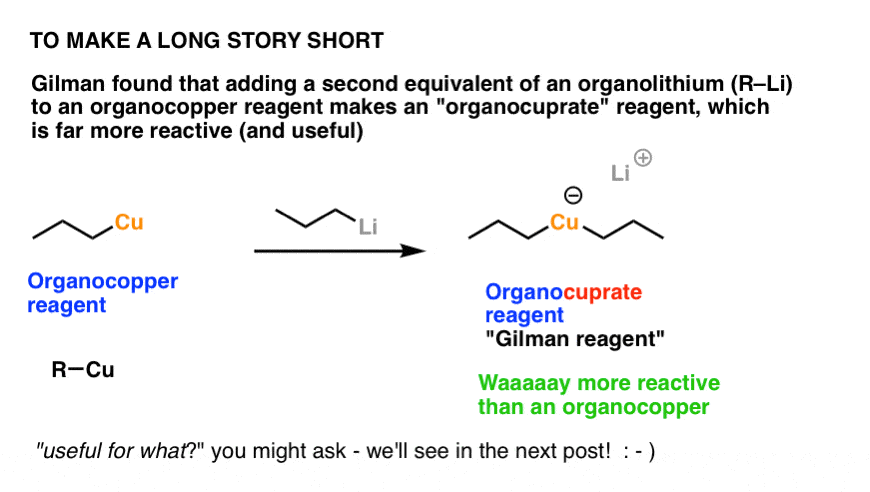
Just like organocopper reagents (and in contrast to Grignards) organocuprates do not generally add to aldehydes, ketones, or esters.
However, as we’ll see in the next post, they do participate in substitution and “conjugate addition” reactions – reactions that Grignards and organolithiums reagents typically don’t do. In this way (as we’ll see) they have a somewhat complimentary function.
8. Summary: Synthesis of Organocuprates
Let’s sum up. We saw that we generally don’t make organocopper reagents directly, but via organolithium or Grignard reagents. However, there’s an even more reactive “cousin” of organocopper reagents – “organocuprates” – that we can also make if we use a 2:1 ratio of organolithium to copper.
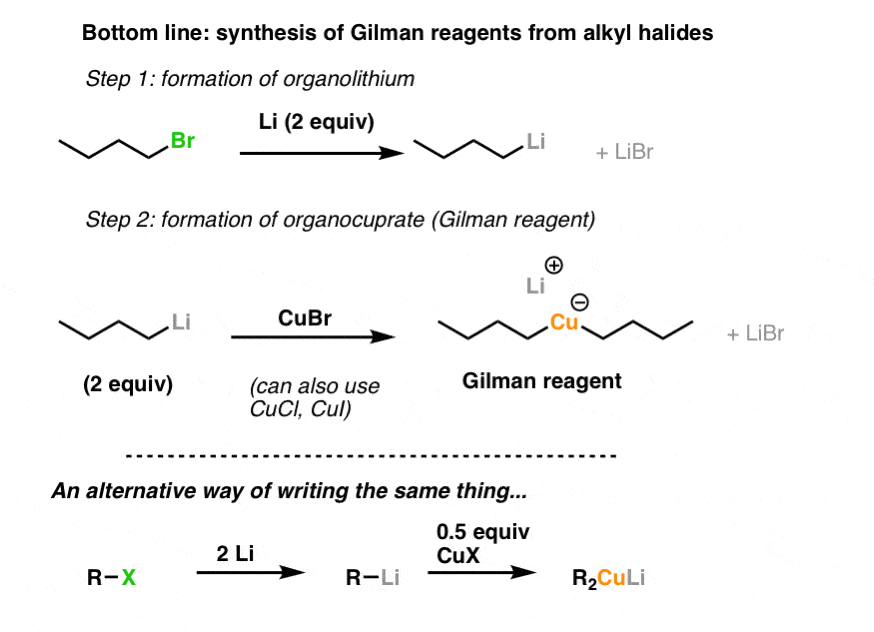
Note again: you need two equivalents of organolithium for every equivalent of copper.
Also note that you can use various different Cu(I) salts, as well as Grignard reagents.
So what’s so great about Gilman reagents, and what can they be used for?
We’ll talk about that in the next post. See you next time!
Next Post: Reactions Of Gilman Reagents
Notes
Related Articles
- Gilman Reagents (Organocuprates): What They’re Used For
- Formation of Grignard and Organolithium Reagents
- What makes a good leaving group?
- Calculating the oxidation state of a carbon
- Grignard Reactions And Synthesis (2)
- Reaction Map: Reactions of Organometallics
- 1,4-addition of organocuprates (Gilman reagents) to enones (MOC Membership)
Bonus question for today. What’s the oxidation state of Cu in Gilman reagents?
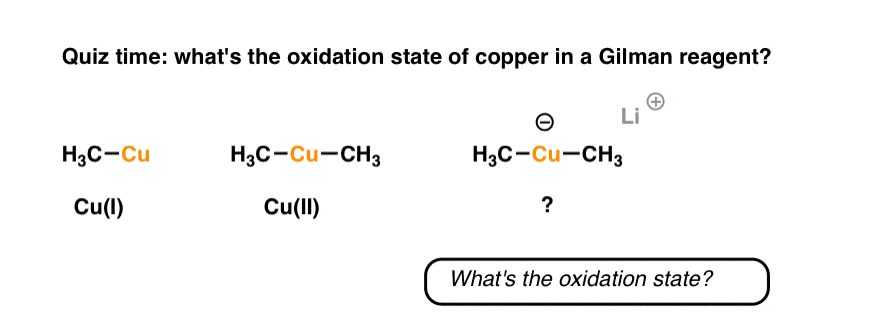
Note 1. Why does transmetallation from lithium (or magnesium) to copper work? It’s a good question. In a nutshell, the carbon-copper bond is stronger than the C-Li or C-Mg bond, and that provides the driving force.
Why is the C-Cu bond stronger than C-Li ? That’s a difficult question to answer succinctly, but I’ll try.
You can think of bonding as having two components:
- an electrostatic component, where there is attraction between opposite charges (such as in salts)
- the overlap of molecular orbitals, resulting in shared electron density between atoms.
Bonding between a carbanion R– with Li+ is almost purely ionic (note the electronegativity difference of about 1.5) meaning that a significant portion of the bonding interaction is due to electrostatic interactions.
In contrast, bonding between C and Cu is considerably more covalent. There’s less of an electronegativity difference (Cu 1.9 vs. C 2.5) and the bonding is better described by metal-carbon bond overlap.
[waves hands] Generally, carbon forms stronger bonds through orbital overlap than via electrostatic interactions. This is largely because carbon is significantly more polarizable (the negative charge is “squishy”, or “diffuse” – we often use the shorthand “soft” to describe this behaviour) than a generally non-polarizable (“hard”) atom like lithium or oxygen. Likewise copper is also a fairly “soft” atom.
If you want to get super technical, for C-Cu the covalent term in the Klopman equation is large, and the coulombic term is small.
Note 2. Organocuprate reaagents are more reactive than organocopper reagents because after transferring R(-), the result will be a neutral organocopper reagent. After organocopper reagents transfer R(-) the result will be an electron-deficient copper ion.
(Advanced) References and Further Reading
- The Preparation of Methylcopper and some Observations on the Decomposition of Organocopper Compounds
Henry Gilman, Reuben G. Jones, and L. A. Woods.
The Journal of Organic Chemistry 1952 17 (12), 1630-1634
DOI: 10.1021/jo50012a009
One of the first papers by Prof. Henry Gilman (U. of Iowa) on ‘Gilman Reagents’ – diorganocopper compounds. In this case he describes the preparation of dimethylcopper.Over the decades, a lotof people have carried out a lot of work in order to elucidate the true nature of copper intermediates and various copper species in reactions. There is a lot of literature in this area, and this is barely scratching the surface: - The composition of lithium methylcuprates in ether solvents
C. Ashby and John J. Watkins.
Journal of the American Chemical Society 1977 99 (16), 5312-5317
DOI: 10.1021/ja00458a015 - Mechanism of thermal decomposition of n-butyl(tri-n-butylphosphine) copper(I)
George M. Whitesides, Erwin R. Stedronsky, Charles P. Casey, and Joseph San Filippo Jr.
Journal of the American Chemical Society 1970 92 (5), 1426-1427
DOI: 10.1021/ja00708a067 - The Chemistry of Carbanions. XII. The Role of Copper in the Conjugate Addition of Organometallic Reagents1
Herbert O. House, William L. Respess, and George M. Whitesides.
The Journal of Organic Chemistry 1966 31 (10), 3128-3141
DOI: 10.1021/jo01348a012 - Autocatalytic decomposition of alkylcopper(I) species. Electron spin resonance spectrum of binuclear copper(O) intermediates
Jay K. Kochi, Keisuke Wada, and Masuhiko Tamura.
Journal of the American Chemical Society 1970 92 (22), 6656-6658
DOI: 10.1021/ja00725a055 - Chemistry of carbanions. XVII. Addition of methyl organometallic reagents to cyclohexenone derivatives
Herbert O. House and William F. Fischer Jr.
The Journal of Organic Chemistry 1968 33 (3), 949-956
DOI: 10.1021/jo01267a004
00 General Chemistry Review
01 Bonding, Structure, and Resonance
- How Do We Know Methane (CH4) Is Tetrahedral?
- Hybrid Orbitals and Hybridization
- How To Determine Hybridization: A Shortcut
- Orbital Hybridization And Bond Strengths
- Sigma bonds come in six varieties: Pi bonds come in one
- Dipole Moments and Dipoles
- A Key Skill: How to Calculate Formal Charge
- The Four Intermolecular Forces and How They Affect Boiling Points
- 3 Trends That Affect Boiling Points
- How To Use Electronegativity To Determine Electron Density (and why NOT to trust formal charge)
- Introduction to Resonance
- How To Use Curved Arrows To Interchange Resonance Forms
- Evaluating Resonance Forms (1) - The Rule of Least Charges
- How To Find The Best Resonance Structure By Applying Electronegativity
- Evaluating Resonance Structures With Negative Charges
- Evaluating Resonance Structures With Positive Charge
- Exploring Resonance: Pi-Donation
- Exploring Resonance: Pi-acceptors
- In Summary: Evaluating Resonance Structures
- Drawing Resonance Structures: 3 Common Mistakes To Avoid
- How to apply electronegativity and resonance to understand reactivity
- Bond Hybridization Practice
- Structure and Bonding Practice Quizzes
- Resonance Structures Practice
02 Acid Base Reactions
- Introduction to Acid-Base Reactions
- Acid Base Reactions In Organic Chemistry
- The Stronger The Acid, The Weaker The Conjugate Base
- Walkthrough of Acid-Base Reactions (3) - Acidity Trends
- Five Key Factors That Influence Acidity
- Acid-Base Reactions: Introducing Ka and pKa
- How to Use a pKa Table
- The pKa Table Is Your Friend
- A Handy Rule of Thumb for Acid-Base Reactions
- Acid Base Reactions Are Fast
- pKa Values Span 60 Orders Of Magnitude
- How Protonation and Deprotonation Affect Reactivity
- Acid Base Practice Problems
03 Alkanes and Nomenclature
- Meet the (Most Important) Functional Groups
- Condensed Formulas: Deciphering What the Brackets Mean
- Hidden Hydrogens, Hidden Lone Pairs, Hidden Counterions
- Don't Be Futyl, Learn The Butyls
- Primary, Secondary, Tertiary, Quaternary In Organic Chemistry
- Branching, and Its Affect On Melting and Boiling Points
- The Many, Many Ways of Drawing Butane
- Wedge And Dash Convention For Tetrahedral Carbon
- Common Mistakes in Organic Chemistry: Pentavalent Carbon
- Table of Functional Group Priorities for Nomenclature
- Summary Sheet - Alkane Nomenclature
- Organic Chemistry IUPAC Nomenclature Demystified With A Simple Puzzle Piece Approach
- Boiling Point Quizzes
- Organic Chemistry Nomenclature Quizzes
04 Conformations and Cycloalkanes
- Staggered vs Eclipsed Conformations of Ethane
- Conformational Isomers of Propane
- Newman Projection of Butane (and Gauche Conformation)
- Introduction to Cycloalkanes
- Geometric Isomers In Small Rings: Cis And Trans Cycloalkanes
- Calculation of Ring Strain In Cycloalkanes
- Cycloalkanes - Ring Strain In Cyclopropane And Cyclobutane
- Cyclohexane Conformations
- Cyclohexane Chair Conformation: An Aerial Tour
- How To Draw The Cyclohexane Chair Conformation
- The Cyclohexane Chair Flip
- The Cyclohexane Chair Flip - Energy Diagram
- Substituted Cyclohexanes - Axial vs Equatorial
- Ranking The Bulkiness Of Substituents On Cyclohexanes: "A-Values"
- Cyclohexane Chair Conformation Stability: Which One Is Lower Energy?
- Fused Rings - Cis-Decalin and Trans-Decalin
- Naming Bicyclic Compounds - Fused, Bridged, and Spiro
- Bredt's Rule (And Summary of Cycloalkanes)
- Newman Projection Practice
- Cycloalkanes Practice Problems
05 A Primer On Organic Reactions
- The Most Important Question To Ask When Learning a New Reaction
- Curved Arrows (for reactions)
- Nucleophiles and Electrophiles
- The Three Classes of Nucleophiles
- Nucleophilicity vs. Basicity
- What Makes A Good Nucleophile?
- What Makes A Good Leaving Group?
- 3 Factors That Stabilize Carbocations
- Equilibrium and Energy Relationships
- 7 Factors that stabilize negative charge in organic chemistry
- 7 Factors That Stabilize Positive Charge in Organic Chemistry
- What's a Transition State?
- Hammond's Postulate
- Learning Organic Chemistry Reactions: A Checklist (PDF)
06 Free Radical Reactions
- Free Radical Reactions
- 3 Factors That Stabilize Free Radicals
- Bond Strengths And Radical Stability
- Free Radical Initiation: Why Is "Light" Or "Heat" Required?
- Initiation, Propagation, Termination
- Monochlorination Products Of Propane, Pentane, And Other Alkanes
- Selectivity In Free Radical Reactions
- Selectivity in Free Radical Reactions: Bromination vs. Chlorination
- Halogenation At Tiffany's
- Allylic Bromination
- Bonus Topic: Allylic Rearrangements
- In Summary: Free Radicals
- Synthesis (2) - Reactions of Alkanes
- Free Radicals Practice Quizzes
07 Stereochemistry and Chirality
- Types of Isomers: Constitutional Isomers, Stereoisomers, Enantiomers, and Diastereomers
- How To Draw The Enantiomer Of A Chiral Molecule
- How To Draw A Bond Rotation
- Introduction to Assigning (R) and (S): The Cahn-Ingold-Prelog Rules
- Assigning Cahn-Ingold-Prelog (CIP) Priorities (2) - The Method of Dots
- Enantiomers vs Diastereomers vs The Same? Two Methods For Solving Problems
- Assigning R/S To Newman Projections (And Converting Newman To Line Diagrams)
- How To Determine R and S Configurations On A Fischer Projection
- The Meso Trap
- Optical Rotation, Optical Activity, and Specific Rotation
- Optical Purity and Enantiomeric Excess
- What's a Racemic Mixture?
- Chiral Allenes And Chiral Axes
- Stereochemistry Practice Problems and Quizzes
08 Substitution Reactions
- Nucleophilic Substitution Reactions - Introduction
- Two Types of Nucleophilic Substitution Reactions
- The SN2 Mechanism
- Why the SN2 Reaction Is Powerful
- The SN1 Mechanism
- The Conjugate Acid Is A Better Leaving Group
- Comparing the SN1 and SN2 Reactions
- Polar Protic? Polar Aprotic? Nonpolar? All About Solvents
- Steric Hindrance is Like a Fat Goalie
- Common Blind Spot: Intramolecular Reactions
- Substitution Practice - SN1
- Substitution Practice - SN2
09 Elimination Reactions
- Elimination Reactions (1): Introduction And The Key Pattern
- Elimination Reactions (2): The Zaitsev Rule
- Elimination Reactions Are Favored By Heat
- Two Elimination Reaction Patterns
- The E1 Reaction
- The E2 Mechanism
- E1 vs E2: Comparing the E1 and E2 Reactions
- Antiperiplanar Relationships: The E2 Reaction and Cyclohexane Rings
- Bulky Bases in Elimination Reactions
- Comparing the E1 vs SN1 Reactions
- Elimination (E1) Reactions With Rearrangements
- E1cB - Elimination (Unimolecular) Conjugate Base
- Elimination (E1) Practice Problems And Solutions
- Elimination (E2) Practice Problems and Solutions
10 Rearrangements
11 SN1/SN2/E1/E2 Decision
- Identifying Where Substitution and Elimination Reactions Happen
- Deciding SN1/SN2/E1/E2 (1) - The Substrate
- Deciding SN1/SN2/E1/E2 (2) - The Nucleophile/Base
- SN1 vs E1 and SN2 vs E2 : The Temperature
- Deciding SN1/SN2/E1/E2 - The Solvent
- Wrapup: The Key Factors For Determining SN1/SN2/E1/E2
- Alkyl Halide Reaction Map And Summary
- SN1 SN2 E1 E2 Practice Problems
12 Alkene Reactions
- E and Z Notation For Alkenes (+ Cis/Trans)
- Alkene Stability
- Alkene Addition Reactions: "Regioselectivity" and "Stereoselectivity" (Syn/Anti)
- Stereoselective and Stereospecific Reactions
- Hydrohalogenation of Alkenes and Markovnikov's Rule
- Hydration of Alkenes With Aqueous Acid
- Rearrangements in Alkene Addition Reactions
- Halogenation of Alkenes and Halohydrin Formation
- Oxymercuration Demercuration of Alkenes
- Hydroboration Oxidation of Alkenes
- m-CPBA (meta-chloroperoxybenzoic acid)
- OsO4 (Osmium Tetroxide) for Dihydroxylation of Alkenes
- Palladium on Carbon (Pd/C) for Catalytic Hydrogenation of Alkenes
- Cyclopropanation of Alkenes
- A Fourth Alkene Addition Pattern - Free Radical Addition
- Alkene Reactions: Ozonolysis
- Oxidative Cleavage of Vicinal Diols With NaIO4 and Pb(OAc)4
- Summary: Three Key Families Of Alkene Reaction Mechanisms
- Synthesis (4) - Alkene Reaction Map, Including Alkyl Halide Reactions
- Alkene Reactions Practice Problems
13 Alkyne Reactions
- Acetylides from Alkynes, And Substitution Reactions of Acetylides
- Partial Reduction of Alkynes With Lindlar's Catalyst
- Partial Reduction of Alkynes With Na/NH3 To Obtain Trans Alkenes
- Alkyne Hydroboration With "R2BH"
- Hydration and Oxymercuration of Alkynes
- Hydrohalogenation of Alkynes
- Alkyne Halogenation: Bromination and Chlorination of Alkynes
- Oxidation of Alkynes With O3 and KMnO4
- Alkenes To Alkynes Via Halogenation And Elimination Reactions
- Alkynes Are A Blank Canvas
- Synthesis (5) - Reactions of Alkynes
- Alkyne Reactions Practice Problems With Answers
14 Alcohols, Epoxides and Ethers
- Alcohols - Nomenclature and Properties
- Alcohols Can Act As Acids Or Bases (And Why It Matters)
- Alcohols - Acidity and Basicity
- The Williamson Ether Synthesis
- Ethers From Alkenes, Tertiary Alkyl Halides and Alkoxymercuration
- Alcohols To Ethers via Acid Catalysis
- Cleavage Of Ethers With Acid
- Epoxides - The Outlier Of The Ether Family
- Opening of Epoxides With Acid
- Epoxide Ring Opening With Base
- Making Alkyl Halides From Alcohols
- Tosylates And Mesylates
- PBr3 and SOCl2
- Elimination Reactions of Alcohols
- Elimination of Alcohols To Alkenes With POCl3
- Alcohol Oxidation: "Strong" and "Weak" Oxidants
- Demystifying The Mechanisms of Alcohol Oxidations
- Protecting Groups For Alcohols
- Thiols And Thioethers
- Calculating the oxidation state of a carbon
- Oxidation and Reduction in Organic Chemistry
- Oxidation Ladders
- SOCl2 Mechanism For Alcohols To Alkyl Halides: SN2 versus SNi
- Alcohol Reactions Roadmap (PDF)
- Alcohol Reaction Practice Problems
- Epoxide Reaction Quizzes
- Oxidation and Reduction Practice Quizzes
15 Organometallics
- What's An Organometallic?
- Formation of Grignard and Organolithium Reagents
- Organometallics Are Strong Bases
- Reactions of Grignard Reagents
- Protecting Groups In Grignard Reactions
- Synthesis Problems Involving Grignard Reagents
- Grignard Reactions And Synthesis (2)
- Organocuprates (Gilman Reagents): How They're Made
- Gilman Reagents (Organocuprates): What They're Used For
- The Heck, Suzuki, and Olefin Metathesis Reactions (And Why They Don't Belong In Most Introductory Organic Chemistry Courses)
- Reaction Map: Reactions of Organometallics
- Grignard Practice Problems
16 Spectroscopy
- Degrees of Unsaturation (or IHD, Index of Hydrogen Deficiency)
- Conjugation And Color (+ How Bleach Works)
- Introduction To UV-Vis Spectroscopy
- UV-Vis Spectroscopy: Absorbance of Carbonyls
- UV-Vis Spectroscopy: Practice Questions
- Bond Vibrations, Infrared Spectroscopy, and the "Ball and Spring" Model
- Infrared (IR) Spectroscopy: A Quick Primer On Interpreting Spectra
- IR Spectroscopy: 4 Practice Problems
- 1H NMR: How Many Signals?
- Homotopic, Enantiotopic, Diastereotopic
- Diastereotopic Protons in 1H NMR Spectroscopy: Examples
- 13-C NMR - How Many Signals
- Liquid Gold: Pheromones In Doe Urine
- Natural Product Isolation (1) - Extraction
- Natural Product Isolation (2) - Purification Techniques, An Overview
- Structure Determination Case Study: Deer Tarsal Gland Pheromone
17 Dienes and MO Theory
- What To Expect In Organic Chemistry 2
- Are these molecules conjugated?
- Conjugation And Resonance In Organic Chemistry
- Bonding And Antibonding Pi Orbitals
- Molecular Orbitals of The Allyl Cation, Allyl Radical, and Allyl Anion
- Pi Molecular Orbitals of Butadiene
- Reactions of Dienes: 1,2 and 1,4 Addition
- Thermodynamic and Kinetic Products
- More On 1,2 and 1,4 Additions To Dienes
- s-cis and s-trans
- The Diels-Alder Reaction
- Cyclic Dienes and Dienophiles in the Diels-Alder Reaction
- Stereochemistry of the Diels-Alder Reaction
- Exo vs Endo Products In The Diels Alder: How To Tell Them Apart
- HOMO and LUMO In the Diels Alder Reaction
- Why Are Endo vs Exo Products Favored in the Diels-Alder Reaction?
- Diels-Alder Reaction: Kinetic and Thermodynamic Control
- The Retro Diels-Alder Reaction
- The Intramolecular Diels Alder Reaction
- Regiochemistry In The Diels-Alder Reaction
- The Cope and Claisen Rearrangements
- Electrocyclic Reactions
- Electrocyclic Ring Opening And Closure (2) - Six (or Eight) Pi Electrons
- Diels Alder Practice Problems
- Molecular Orbital Theory Practice
18 Aromaticity
- Introduction To Aromaticity
- Rules For Aromaticity
- Huckel's Rule: What Does 4n+2 Mean?
- Aromatic, Non-Aromatic, or Antiaromatic? Some Practice Problems
- Antiaromatic Compounds and Antiaromaticity
- The Pi Molecular Orbitals of Benzene
- The Pi Molecular Orbitals of Cyclobutadiene
- Frost Circles
- Aromaticity Practice Quizzes
19 Reactions of Aromatic Molecules
- Electrophilic Aromatic Substitution: Introduction
- Activating and Deactivating Groups In Electrophilic Aromatic Substitution
- Electrophilic Aromatic Substitution - The Mechanism
- Ortho-, Para- and Meta- Directors in Electrophilic Aromatic Substitution
- Understanding Ortho, Para, and Meta Directors
- Why are halogens ortho- para- directors?
- Disubstituted Benzenes: The Strongest Electron-Donor "Wins"
- Electrophilic Aromatic Substitutions (1) - Halogenation of Benzene
- Electrophilic Aromatic Substitutions (2) - Nitration and Sulfonation
- EAS Reactions (3) - Friedel-Crafts Acylation and Friedel-Crafts Alkylation
- Intramolecular Friedel-Crafts Reactions
- Nucleophilic Aromatic Substitution (NAS)
- Nucleophilic Aromatic Substitution (2) - The Benzyne Mechanism
- Reactions on the "Benzylic" Carbon: Bromination And Oxidation
- The Wolff-Kishner, Clemmensen, And Other Carbonyl Reductions
- More Reactions on the Aromatic Sidechain: Reduction of Nitro Groups and the Baeyer Villiger
- Aromatic Synthesis (1) - "Order Of Operations"
- Synthesis of Benzene Derivatives (2) - Polarity Reversal
- Aromatic Synthesis (3) - Sulfonyl Blocking Groups
- Birch Reduction
- Synthesis (7): Reaction Map of Benzene and Related Aromatic Compounds
- Aromatic Reactions and Synthesis Practice
- Electrophilic Aromatic Substitution Practice Problems
20 Aldehydes and Ketones
- What's The Alpha Carbon In Carbonyl Compounds?
- Nucleophilic Addition To Carbonyls
- Aldehydes and Ketones: 14 Reactions With The Same Mechanism
- Sodium Borohydride (NaBH4) Reduction of Aldehydes and Ketones
- Grignard Reagents For Addition To Aldehydes and Ketones
- Wittig Reaction
- Hydrates, Hemiacetals, and Acetals
- Imines - Properties, Formation, Reactions, and Mechanisms
- All About Enamines
- Breaking Down Carbonyl Reaction Mechanisms: Reactions of Anionic Nucleophiles (Part 2)
- Aldehydes Ketones Reaction Practice
21 Carboxylic Acid Derivatives
- Nucleophilic Acyl Substitution (With Negatively Charged Nucleophiles)
- Addition-Elimination Mechanisms With Neutral Nucleophiles (Including Acid Catalysis)
- Basic Hydrolysis of Esters - Saponification
- Transesterification
- Proton Transfer
- Fischer Esterification - Carboxylic Acid to Ester Under Acidic Conditions
- Lithium Aluminum Hydride (LiAlH4) For Reduction of Carboxylic Acid Derivatives
- LiAlH[Ot-Bu]3 For The Reduction of Acid Halides To Aldehydes
- Di-isobutyl Aluminum Hydride (DIBAL) For The Partial Reduction of Esters and Nitriles
- Amide Hydrolysis
- Thionyl Chloride (SOCl2) And Conversion of Carboxylic Acids to Acid Halides
- Diazomethane (CH2N2)
- Carbonyl Chemistry: Learn Six Mechanisms For the Price Of One
- Making Music With Mechanisms (PADPED)
- Carboxylic Acid Derivatives Practice Questions
22 Enols and Enolates
- Keto-Enol Tautomerism
- Enolates - Formation, Stability, and Simple Reactions
- Kinetic Versus Thermodynamic Enolates
- Aldol Addition and Condensation Reactions
- Reactions of Enols - Acid-Catalyzed Aldol, Halogenation, and Mannich Reactions
- Claisen Condensation and Dieckmann Condensation
- Decarboxylation
- The Malonic Ester and Acetoacetic Ester Synthesis
- The Michael Addition Reaction and Conjugate Addition
- The Robinson Annulation
- Haloform Reaction
- The Hell–Volhard–Zelinsky Reaction
- Enols and Enolates Practice Quizzes
23 Amines
- The Amide Functional Group: Properties, Synthesis, and Nomenclature
- Basicity of Amines And pKaH
- 5 Key Basicity Trends of Amines
- The Mesomeric Effect And Aromatic Amines
- Nucleophilicity of Amines
- Alkylation of Amines (Sucks!)
- Reductive Amination
- The Gabriel Synthesis
- Some Reactions of Azides
- The Hofmann Elimination
- The Hofmann and Curtius Rearrangements
- The Cope Elimination
- Protecting Groups for Amines - Carbamates
- The Strecker Synthesis of Amino Acids
- Introduction to Peptide Synthesis
- Reactions of Diazonium Salts: Sandmeyer and Related Reactions
- Amine Practice Questions
24 Carbohydrates
- D and L Notation For Sugars
- Pyranoses and Furanoses: Ring-Chain Tautomerism In Sugars
- What is Mutarotation?
- Reducing Sugars
- The Big Damn Post Of Carbohydrate-Related Chemistry Definitions
- The Haworth Projection
- Converting a Fischer Projection To A Haworth (And Vice Versa)
- Reactions of Sugars: Glycosylation and Protection
- The Ruff Degradation and Kiliani-Fischer Synthesis
- Isoelectric Points of Amino Acids (and How To Calculate Them)
- Carbohydrates Practice
- Amino Acid Quizzes
25 Fun and Miscellaneous
- A Gallery of Some Interesting Molecules From Nature
- Screw Organic Chemistry, I'm Just Going To Write About Cats
- On Cats, Part 1: Conformations and Configurations
- On Cats, Part 2: Cat Line Diagrams
- On Cats, Part 4: Enantiocats
- On Cats, Part 6: Stereocenters
- Organic Chemistry Is Shit
- The Organic Chemistry Behind "The Pill"
- Maybe they should call them, "Formal Wins" ?
- Why Do Organic Chemists Use Kilocalories?
- The Principle of Least Effort
- Organic Chemistry GIFS - Resonance Forms
- Reproducibility In Organic Chemistry
- What Holds The Nucleus Together?
- How Reactions Are Like Music
- Organic Chemistry and the New MCAT
26 Organic Chemistry Tips and Tricks
- Common Mistakes: Formal Charges Can Mislead
- Partial Charges Give Clues About Electron Flow
- Draw The Ugly Version First
- Organic Chemistry Study Tips: Learn the Trends
- The 8 Types of Arrows In Organic Chemistry, Explained
- Top 10 Skills To Master Before An Organic Chemistry 2 Final
- Common Mistakes with Carbonyls: Carboxylic Acids... Are Acids!
- Planning Organic Synthesis With "Reaction Maps"
- Alkene Addition Pattern #1: The "Carbocation Pathway"
- Alkene Addition Pattern #2: The "Three-Membered Ring" Pathway
- Alkene Addition Pattern #3: The "Concerted" Pathway
- Number Your Carbons!
- The 4 Major Classes of Reactions in Org 1
- How (and why) electrons flow
- Grossman's Rule
- Three Exam Tips
- A 3-Step Method For Thinking Through Synthesis Problems
- Putting It Together
- Putting Diels-Alder Products in Perspective
- The Ups and Downs of Cyclohexanes
- The Most Annoying Exceptions in Org 1 (Part 1)
- The Most Annoying Exceptions in Org 1 (Part 2)
- The Marriage May Be Bad, But the Divorce Still Costs Money
- 9 Nomenclature Conventions To Know
- Nucleophile attacks Electrophile
27 Case Studies of Successful O-Chem Students
- Success Stories: How Corina Got The The "Hard" Professor - And Got An A+ Anyway
- How Helena Aced Organic Chemistry
- From a "Drop" To B+ in Org 2 – How A Hard Working Student Turned It Around
- How Serge Aced Organic Chemistry
- Success Stories: How Zach Aced Organic Chemistry 1
- Success Stories: How Kari Went From C– to B+
- How Esther Bounced Back From a "C" To Get A's In Organic Chemistry 1 And 2
- How Tyrell Got The Highest Grade In Her Organic Chemistry Course
- This Is Why Students Use Flashcards
- Success Stories: How Stu Aced Organic Chemistry
- How John Pulled Up His Organic Chemistry Exam Grades
- Success Stories: How Nathan Aced Organic Chemistry (Without It Taking Over His Life)
- How Chris Aced Org 1 and Org 2
- Interview: How Jay Got an A+ In Organic Chemistry
- How to Do Well in Organic Chemistry: One Student's Advice
- "America's Top TA" Shares His Secrets For Teaching O-Chem
- "Organic Chemistry Is Like..." - A Few Metaphors
- How To Do Well In Organic Chemistry: Advice From A Tutor
- Guest post: "I went from being afraid of tests to actually looking forward to them".
[quote]
Also note that you can use various different Cu(I) salts, as well as Grignard reagents
[/quote]
Does this statement mean that Grignard reagents can also be used in the formation of organocuprates? Does the magnesium participate as the cation in this particular case? If so, what would the handling requirements be for a Grignard reagent-derived organocuprate?